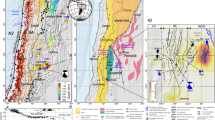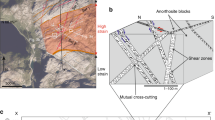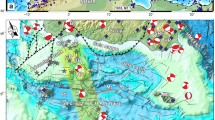Abstract
Rock exhumation and surface uplift over subduction zones require part of the stresses to cause crustal thickening within the wedge and/or through basal accretion. Although accumulated elastic strain around subduction zones is released through megathrust earthquakes and related aftershocks, these large events often result in no permanent forearc surface uplift. Nevertheless, energy is also released by more frequent and dispersed background seismicity, a signal that is often overlooked. Here we investigate the variability of this energy along the Peru–Chile and Japan margins. We find that the pattern of background seismicity correlates with the margin-parallel long-wavelength wedge geometry and with published estimates of geologic-timescale coastal uplift. Furthermore, the orientation of the principal stresses related to these background events is consistent with contractional seismicity, predominantly located at the deep (30–60 km) plate interface depth. Taken together, these results indicate that background seismicity is associated with crustal thickening during the megathrust interseismic period. This mechanism may contribute substantially to the surface uplift of subduction margins over geologic timescales.
This is a preview of subscription content, access via your institution
Access options
Access Nature and 54 other Nature Portfolio journals
Get Nature+, our best-value online-access subscription
$29.99 / 30 days
cancel any time
Subscribe to this journal
Receive 12 print issues and online access
$259.00 per year
only $21.58 per issue
Buy this article
- Purchase on Springer Link
- Instant access to full article PDF
Prices may be subject to local taxes which are calculated during checkout




Similar content being viewed by others
Data availability
The raw data used in this study (seismic catalogue, digital elevation models, coastal uplift data and shelf-break location data) are freely available and accessible at their respective cited references/URLs. Source data are provided with this paper.
Code availability
Data analyses and plotting were performed in Python using the packages Matplotlib64, GeoPandas65 and functions from the ArcPy library of the software ArcGIS. All figures were additionally edited in the software Affinity Designer. The DBSCAN clustering algorithm is available in the Python library Scikit-learn54. The mathematical steps necessary to reproduce the results are illustrated in Main and Methods sections. Python scripts that integrate the described workflow are available from the corresponding author upon reasonable request.
References
Wang, K., Hu, Y. & He, J. Deformation cycles of subduction earthquakes in a viscoelastic Earth. Nature 484, 327–332 (2012).
Béjar-Pizarro, M. et al. Andean structural control on interseismic coupling in the North Chile subduction zone. Nat. Geosci. 6, 462–467 (2013).
Li, S., Moreno, M., Bedford, J., Rosenau, M. & Oncken, O. Revisiting viscoelastic effects on interseismic deformation and locking degree: a case study of the Peru–North Chile subduction zone. J. Geophys. Res. Solid Earth 120, 4522–4538 (2015).
Hyndman, R. D. & Wang, K. The rupture zone of Cascadia great earthquakes from current deformation and the thermal regime. J. Geophys. Res. Solid Earth 100, 22133–22154 (1995).
King, G. P. C., Stein, R. S. & Rundle, J. B. The growth of geological structures by repeated earthquakes 1. conceptual framework. J. Geophys. Res. 93, 13307–13318 (1988).
Baker, A., Allmendinger, R. W., Owen, L. A. & Rech, J. A. Permanent deformation caused by subduction earthquakes in northern Chile. Nat. Geosci. 6, 492–496 (2013).
Simpson, G. Accumulation of permanent deformation during earthquake cycles on reverse faults. J. Geophys. Res. Solid Earth 120, 1958–1974 (2015).
Delano, J. E. et al. Influence of the megathrust earthquake cycle on upper-plate deformation in the Cascadia forearc of Washington State, USA. Geology 45, 1051–1054 (2017).
Mouslopoulou, V., Oncken, O., Hainzl, S. & Nicol, A. Uplift rate transients at subduction margins due to earthquake clustering. Tectonics 35, 2370–2384 (2016).
Saillard, M. et al. From the seismic cycle to long-term deformation: linking seismic coupling and Quaternary coastal geomorphology along the Andean megathrust: interseismic coupling/coastal morphology. Tectonics 36, 241–256 (2017).
Clark, K. et al. Geological evidence for past large earthquakes and tsunamis along the Hikurangi subduction margin, New Zealand. Mar. Geol. 412, 139–172 (2019).
Melnick, D. Rise of the central Andean coast by earthquakes straddling the Moho. Nat. Geosci. 9, 401–407 (2016).
Lay, T. et al. Depth-varying rupture properties of subduction zone megathrust faults. J. Geophys. Res. Solid Earth 117, B04311 (2012).
Sawai, Y. Transient uplift after a 17th-century earthquake along the Kuril Subduction Zone. Science 306, 1918–1920 (2004).
Peña, C. et al. Role of lower crust in the postseismic deformation of the 2010 Maule earthquake: insights from a model with power-law rheology. Pure Appl. Geophys. 176, 3913–3928 (2019).
Comte, D. & Pardo, M. Reappraisal of great historical earthquakes in the northern Chile and southern Peru seismic gaps. Nat. Hazards 4, 23–44 (1991).
Usami, K., Ikehara, K., Kanamatsu, T. & McHugh, C. M. Supercycle in great earthquake recurrence along the Japan Trench over the last 4000 years. Geosci. Lett. 5, 11 (2018).
von Huene, R. & Scholl, D. W. Observations at convergent margins concerning sediment subduction, subduction erosion, and the growth of continental crust. Rev. Geophys. 29, 279–316 (1991).
Heki, K. Space geodetic observation of deep basal subduction erosion in northeastern Japan. Earth Planet. Sci. Lett. 219, 13–20 (2004).
Audin, L., Lacan, Pierre, Tavera, H. & Bondoux, F. Upper plate deformation and seismic barrier in front of Nazca subduction zone: the Chololo fault system and active tectonics along the coastal cordillera, southern Peru. Tectonophysics 459, 174–185 (2008).
Allmendinger, R. W. & González, G. Invited review paper: Neogene to Quaternary tectonics of the coastal cordillera, northern Chile. Tectonophysics 495, 93–110 (2010).
Noda, A. Forearc basins: types, geometries, and relationships to subduction zone dynamics. Geol. Soc. Am. Bull. 128, 879–895 (2016).
Regard, V. et al. Renewed uplift of the Central Andes Forearc revealed by coastal evolution during the Quaternary. Earth Planet. Sci. Lett. 297, 199–210 (2010).
Madella, A., Delunel, R., Audin, L. & Schlunegger, F. Why is there no coastal cordillera at the Arica Bend (western central Andes)? Basin Res. 30, 248–268 (2018).
Matsu’ura, T., Furusawa, A. & Saomoto, H. Long-term and short-term vertical velocity profiles across the forearc in the NE Japan subduction zone. Quat. Res. 71, 227–238 (2009).
Tam, E. & Yokoyama, Y. A review of MIS 5e sea-level proxies around Japan. Earth Syst. Sci. Data 13, 1477–1497 (2021).
Willett, S., Beaumont, C. & Fullsack, P. Mechanical model for the tectonics of doubly vergent compressional orogens. Geology 21, 371–374 (1993).
Comte, D., Farias, M., Roecker, S. & Russo, R. The nature of the subduction wedge in an erosive margin: insights from the analysis of aftershocks of the 2015 Mw 8.3 Illapel earthquake beneath the Chilean Coastal Range. Earth Planet. Sci. Lett. 520, 50–62 (2019).
Hayes, G. P. et al. Slab2, a comprehensive subduction zone geometry model. Science 362, 58–61 (2018).
Cubas, N., Avouac, J.-P., Souloumiac, P. & Leroy, Y. Megathrust friction determined from mechanical analysis of the forearc in the Maule earthquake area. Earth Planet. Sci. Lett. 381, 92–103 (2013).
Dahlen, F. A., Suppe, J. & Davis, D. Mechanics of fold‐and‐thrust belts and accretionary wedges: cohesive Coulomb theory. J. Geophys. Res. 89, 10087–10101 (1984).
Malatesta, L. C., Bruhat, L., Finnegan, N. J. & Olive, J.-A. L. Co-location of the downdip end of seismic coupling and the continental shelf break. J. Geophys. Res. Solid Earth 126, e2020JB019589 (2021).
Mouslopoulou, V., Nicol, A., Begg, J., Oncken, O. & Moreno, M. Clusters of megaearthquakes on upper plate faults control the Eastern Mediterranean hazard. Geophys. Res. Lett. 42, 10282–10289 (2015).
Madella, A., Delunel, R., Oncken, O., Szidat, S. & Schlunegger, F. Transient uplift of a long-term quiescent coast inferred from raised fan delta sediments. Lithosphere 9, 796–802 (2017).
Shaw, B. et al. Eastern Mediterranean tectonics and tsunami hazard inferred from the AD 365 earthquake. Nat. Geosci. 1, 268–276 (2008).
van Dinther, Y. et al. The seismic cycle at subduction thrusts: insights from seismo-thermo-mechanical models. J. Geophys. Res. Solid Earth 118, 6183–6202 (2013).
Jolivet, R. et al. Interseismic loading of subduction megathrust drives long-term uplift in northern Chile. Geophys. Res. Lett. 47, e2019GL085377 (2020).
von Huene, R., Weinrebe, W. & Heeren, F. Subduction erosion along the North Chile margin. Geodynamics 27, 345–358 (1999).
Wörner, G., Uhlig, D., Kohler, I. & Seyfried, H. Evolution of the West Andean Escarpment at 18°S (N. Chile) during the last 25 Ma: uplift, erosion and collapse through time. Tectonophysics 345, 183–198 (2002).
Hoke, G. D. et al. Geomorphic evidence for post-10 Ma uplift of the western flank of the central Andes 18°30′–22°S. Tectonics 26, TC5021 (2007).
Becerra, J. et al. Gravitational deformation and inherited structural control on slope morphology in the subduction zone of north-central Chile (ca. 29–33°S). Basin Res. 29, 798–815 (2017).
Geersen, J. et al. Does permanent extensional deformation in lower forearc slopes indicate shallow plate-boundary rupture? Earth Planet. Sci. Lett. 489, 17–27 (2018).
Lallemand, S. High rates of arc consumption by subduction processes: some consequences. Geology 23, 551–554 (1995).
Darwin, C. R. Geological Observations on South America. Being the Third Part of the Geology of the Voyage of the Beagle, under the Command of Capt. Fitzroy, R.N. during the Years 1832 to 1836 (Smith Elder, 1846).
Atwater, B. F. et al. Summary of coastal geologic evidence for past great earthquakes at the Cascadia Subduction Zone. Earthq. Spectra 11, 1–18 (1995).
Dielforder, A., Hetzel, R. & Oncken, O. Megathrust shear force controls mountain height at convergent plate margins. Nature 582, 225–229 (2020).
Gao, X. & Wang, K. Strength of stick-slip and creeping subduction megathrusts from heat flow observations. Science 345, 1038–1041 (2014).
Dielforder, A. Constraining the strength of megathrusts from fault geometries and application to the Alpine collision zone. Earth Planet. Sci. Lett. 474, 49–58 (2017).
Scholz, C. H. Earthquakes and friction laws. Nature 391, 37–42 (1998).
Wang, K. & Hu, Y. Accretionary prisms in subduction earthquake cycles: the theory of dynamic Coulomb wedge. J. Geophys. Res. Solid Earth 111, B06410 (2006).
Bonini, M. Seismic loading of fault-controlled fluid seepage systems by great subduction earthquakes. Sci. Rep. 9, 11332 (2019).
Wyss, M. & Wiemer, S. Change in the probability for earthquakes in Southern California due to the Landers magnitude 7.3 earthquake. Science 290, 1334–1338 (2000).
Clauset, A., Shalizi, C. R. & Newman, M. E. J. Power-law distributions in empirical data. SIAM Rev. 51, 661–703 (2009).
Pedregosa, F. et al. Scikit-learn: machine learning in Python. J. Mach. Learn. Res. 12, 2825–2830 (2011).
Kanamori, H. Magnitude scale and quantification of earthquakes. Tectonophysics 93, 185–199 (1983).
Centenary Edition of the GEBCO Digital Atlas (British Oceanographic Data Centre, 2003).
Davis, D., Suppe, J. & Dahlen, F. A. Mechanics of fold‐and‐thrust belts and accretionary wedges. J. Geophys. Res. 88, 1153–1172 (1983).
Lehner, F. K. Comments on “Noncohesive critical Coulomb wedges: an exact solution” by F. A. Dahlen. J. Geophys. Res. Solid Earth 91, 793–796 (1986).
Wang, K., He, J. & Hu, Y. A note on pore fluid pressure ratios in the Coulomb wedge theory. Geophys. Res. Lett. 33, L19310 (2006).
Ruff, L. J. & Tichelaar, B. W. in Subduction: Top to Bottom (eds Bebout, G. E. et al.) 105 (Wiley, 1996).
Anderson, R. S., Densmore, A. L. & Ellis, M. A. The generation and degradation of marine terraces. Basin Res. 11, 7–19 (1999).
Kanda, R. V. S., Hetland, E. A. & Simons, M. An asperity model for fault creep and interseismic deformation in northeastern Japan. Geophys. J. Int. 192, 38–57 (2013).
Shrivastava, M. N. et al. Earthquake segmentation in northern Chile correlates with curved plate geometry. Sci. Rep. 9, 4403 (2019).
Hunter, J. D. Matplotlib: a 2D graphics environment. Comput. Sci. Eng. 9, 90–95 (2007).
Jordahl, K. geopandas/geopandas: v0.8.1. zenodo https://doi.org/10.5281/zenodo.3946761 (2020).
Acknowledgements
Research was funded through the Swiss National Science Foundation Early Postdoc Mobility grant no. 178460 awarded to A.M. The authors thank A. Dielforder and O. Oncken for inspiring discussions, as well as M. Farías and V. Mouslopoulou for constructive comments.
Author information
Authors and Affiliations
Contributions
A.M. developed the study, collected and analysed the data. A.M. and T.A.E. contributed to writing the manuscript.
Corresponding author
Ethics declarations
Competing interests
The authors declare no competing interests.
Additional information
Peer review information Primary Handling Editor: Stefan Lachowycz. Nature Geoscience thanks Vasiliki Mouslopoulou and Marcelo Farías for their contribution to the peer review of this work.
Publisher’s note Springer Nature remains neutral with regard to jurisdictional claims in published maps and institutional affiliations.
Extended data
Extended Data Fig. 1 Margin-parallel variations of background seismicity and proxies for long-term uplift along the Peru-Chile margin.
BSM (shades of black) is compared to changes of topographic slope (shades of blue), basal friction (shades of green), inverse of the trench-shelf break distance (shades of magenta) and long-term uplift rates from Melnick12 (shades of purple). Smoothing length increases with transparency from 150 to 300 km. Correlation coefficients R refer to the 250 km smoothing length (all p-values < 0.05, except where in italics).
Extended Data Fig. 2 Margin-parallel variations of background seismicity and proxies for long-term uplift along the Japan margin.
BSM (shades of black) is compared to changes of topographic slope (shades of blue), basal friction (shades of green), inverse of the trench-shelf break distance (shades of magenta) and long-term uplift rates from Tam & Yokohama26 (shades of purple). Smoothing length increases with transparency from 150 to 300 km. Correlation coefficients R refer to the 250 km smoothing length (all p-values < 0.05, except where in italics).
Extended Data Fig. 3 Plots of background seismic moment (y axes) against each of the analyzed proxy for long-term uplift (x axis) in the Peru-Chile margin.
The circles sample the margin with a margin-parallel 25-km step size, with a 250-km-smoothing length. Color coding refers to the latitude along the dashed yellow line in Fig. 1 of the main text. All Pearson correlation coefficients are associated with p-values < 0.05, except where in italics.
Extended Data Fig. 4 Plots of background seismic moment (y axes) against each of the analyzed proxy for long-term uplift (x axis) in the Japan margin.
The circles sample the margin with a margin-parallel 25-km step size, with a 250-km-smoothing length. Color coding refers to the latitude along the dashed yellow line in Fig. 1 of the main text. All Pearson correlation coefficients are associated with p-values < 0.05, except where in italics.
Extended Data Fig. 5 Stereographic projection of maximum and minimum (σ1: white circles, σ3: black circles) compressive stress orientations from focal mechanisms of background events.
The plotted 105 (Peru-Chile) and 165 (Japan) focal mechanisms refer exclusively to events from the considered background seismicity catalogues. They are in the 30–60 km-depth range and within 15 km vertical distance from the plate interface. For illustrative purposes, the shading shows the beach ball diagram obtained for the most frequent orientation of the focal mechanisms. Red arrows inform the regional convergence direction62,63.
Supplementary information
Supplementary information
Information on how to download the raw seismic catalogues. Supplementary Tables 1–4 and Figs. 1 and 2.
Supplementary Table 5
A .csv file containing latitude, longitude, elevation, topographic slope angle, slab dip angle, slab depth and effective coefficient of basal friction for the analysed portion of the Japan margin.
Supplementary Table 6
A .csv file containing latitude, longitude, elevation, topographic slope angle, slab dip angle, slab depth and effective coefficient of basal friction for the analysed portion of the Peru–Chile margin.
Source data
Source Data Fig. 2
Line Plot Source Data
Source Data Fig. 3
Statistical Source Data
Source Data Extended Data Fig. 1
Line Plot Source Data
Source Data Extended Data Fig. 2
Line Plot Source Data
Source Data Extended Data Fig. 3
Scatter Plot Source Data
Source Data Extended Data Fig. 4
Scatter Plot Source Data
Source Data Extended Data Fig. 5
Stereographic Plot Source Data
Rights and permissions
About this article
Cite this article
Madella, A., Ehlers, T.A. Contribution of background seismicity to forearc uplift. Nat. Geosci. 14, 620–625 (2021). https://doi.org/10.1038/s41561-021-00779-0
Received:
Accepted:
Published:
Issue Date:
DOI: https://doi.org/10.1038/s41561-021-00779-0



